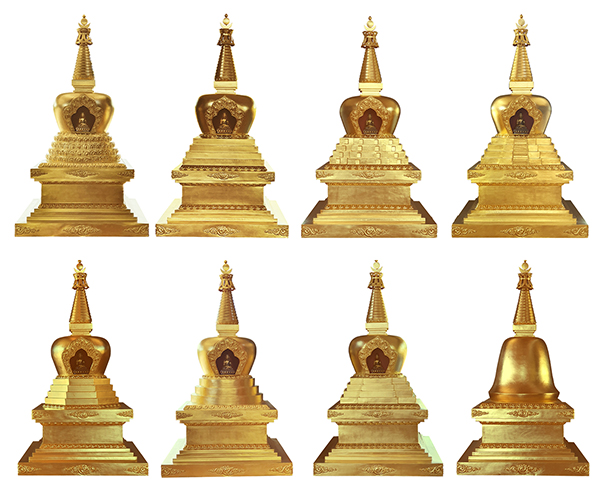What is a Stupa?
A blessed support for wishes
A Little History…
A stupa is a reliquary monument specific to Buddhism. Inspired by ancient Indian burial mounds, its principal function is to welcome the relics of great masters or holy persons. This tradition goes back to the time of Buddha Shakyamuni. It was he who, at the request of his disciples, gave very precise instructions on the methods for constructing a stupa and the form it must have. After his death and cremation, eight great stupas were constructed in order to commemorate the principal events of his life, to mark sacred locations where he had spent time, and to shelter his the relics of his bones. Later on, this practice continued and one likewise finds stupas in all of the countries to which Buddhism has spread. Their form varies according to the culture, but their role remains the same. The different steps of their construction have been codified and ritualized.
A stupa is at once a way to remind oneself of the presence of a master after his physical departure and a support for offering that brings numerous benefits.
The Stupa’s Symbolism
The stupa can be considered the most ancient stylized representation of the Buddha. It symbolizes his mind in the same way that statues represent his physical form and sacred texts his speech.
The form of the stupa itself evokes, from the base to the summit, the path toward liberation from suffering—the passage from ordinary being to enlightened being. Different meanings are given to the elements that compose a stupa. It specifically represents the various qualities of mind that the Buddha described and that the practitioner develops on the path.
A stupa is not only a monument. It is also a support for practice and, as such, it contains representations of the body (statues), speech (mantras and teachings) and the mind (mandalas) of the Buddha. Being in-and-of itself an offering, the stupa also contains numerous precious substances.
An emblem of Buddhism throughout the world, a stupa is a reminder of the serene state of mind to be cultivated in order to bring peace and harmony. In connection with this, one can circumambulate the stupa while making wishes for the benefit of beings.


The Eight Stupas: Eight Steps in Shakyamuni Buddha’s Life
In Astamahasthanacaitya–stotras, the Indian master Nagarjuna associates the eight stupas with the four principle pilgrimage sites—the Buddha’s birth in Lumbini, his enlightenment in Bodh Gaya, his first teaching in Sarnath, and his death in Kushinagar—and four extraordinary acts—the demonstration of miracles, the return from the divine realms, the reconciliation of the divided community, and the complete victory.
The Different Types of Stupas
In the tradition of Tibetan Buddhism, there are eight specific forms that commemorate important moments in the life of Buddha Shakyamuni. One finds a specific form of stupa for each event marking the Buddha’s life, from his birth to his death, including his attainment of enlightenment. The amount of elements involved and the manner of assembly vary from one type to another. For Dhagpo’s new stupa, Thaye Dorje, His Holiness the17th Gyalwa Karmapa, choose the form that commemorates the Buddha’s return from the divine realm of Tushita. The form of the stupa already present at Dhagpo is that of the Buddha’s enlightenment.
The Benefits Generated by the Construction of a Stupa
There are many! The Buddha described the benefits that unfold from the construction of a stupa and also from its use as a support for practice: for prostrations and circumambulation while making wishes for the benefit of all beings. The benefits are numerous and varied: they concern relative aspects of existence (pleasant and positive life conditions, for example) and other, more ultimate, benefits connected with the practice of Dharma and freedom from suffering.
Building a support for practice that will survive the ages and be used by thousands of well-intentioned individuals contributes to “developing all that is beneficial in the world,” as Gendun Rinpoche said, regardless of the size of the stupa.



